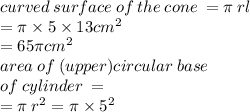Volume of the remaining solid = 628 cm^2
Whole surface area = 659.4 cm^2
Explanation:
Now, Given that:-
Diameter (d) = 10 cm
So, Radius (r) = 10/2 = 5cm
Height of the cylinder = 12cm.


Radius of the cone = 5 cm.
Height of the cone = 12 cm.


Volume of the cone = 1/3 *πr^2h

therefore, the volume of the remaining solid

Curved surface of the cylinder =


therefore, The whole surface area of the remaining solid
= curved surface area of cylinder + curved surface area of cone + area of (upper) circular base of cylinder

Hope it helps you!!